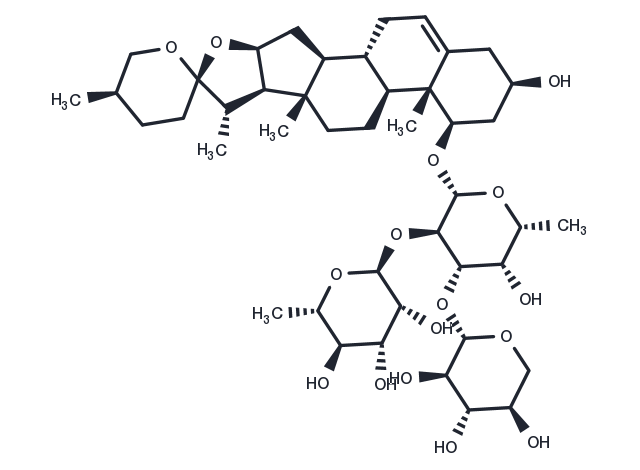Powder: -20°C for 3 years | In solvent: -80°C for 1 year


Ophiopogonin-D significantly inhibited the in vitro and in vivo growth of prostate cells via RIPK1. Ophiopogonin-D may be developed as a potential anti-prostate cancer agent.

| Pack Size | Availability | Price/USD | Quantity |
|---|---|---|---|
| 1 mg | In stock | $ 71.00 | |
| 5 mg | In stock | $ 179.00 | |
| 10 mg | In stock | $ 238.00 | |
| 25 mg | In stock | $ 397.00 | |
| 50 mg | In stock | $ 589.00 | |
| 100 mg | In stock | $ 843.00 | |
| 1 mL * 10 mM (in DMSO) | In stock | $ 268.00 |



| Description | Ophiopogonin-D significantly inhibited the in vitro and in vivo growth of prostate cells via RIPK1. Ophiopogonin-D may be developed as a potential anti-prostate cancer agent. |
| In vitro | Ophiopogonin D(OPD) was shown to exert potent anti-tumor activity against PC3 cells.?It induced apoptosis via a RIPK1-related pathway, increased the protein expression levels of RIPK1 and Bim, and decreased the levels of cleaved-RIPK1, caspase 8, cleaved-caspase 8, Bid, caspase 10, and cleaved-caspase 10.?OPD' also increased the mRNA expression of Bim.?The protein expression of Bim was decreased when cells were pre-treated with necrostatin-1[1]. |
| In vivo | Ophiopogonin D(OPD)′ treatment led to significant tumor growth inhibition at a dose of 5.0 mg/kg bodyweight, beginning on Day 6 of treatment (p = 0.034).?At the end of the study (Day 24), the tumor tissues were excised, photographed, and weighed.?Treatment with 5.0 mg/kg bodyweight OPD′ resulted in significant (p = 0.000) tumor growth inhibition by approximately 79.8% on Day 24 compared to the vehicle treatment.?The 5.0 mg/kg dose led to significantly stronger tumor growth inhibition than the 2.5 mg/kg dose (p = 0.000).?There was not a significant loss of body weight in any of the groups[1]. |
| Cell Research | The CCK-8 assay was used to assess the viability of prostate cancer cells.?The cell morphology was examined by an ultrastructural analysis via transmission electron microscopy.?Cells in apoptosis (early and late stages) were detected using an Annexin V-FITC/propidium iodide kit with a FACSCaliber flow cytometer.?JC-1, a cationic lipophilic probe, was employed to measure the mitochondrial membrane potential (MMP) of PC3 cells.?Changes in the protein expression of RIPK1, C-RIPK1, caspase 8, cleaved-caspase 8, Bim, Bid, caspase 10, and cleaved-caspase 10 were evaluated by Western blotting.?The mRNA expression of Bim was examined by quantitative real-time reverse transcription polymerase chain reaction.?Z-VAD-FMK (a caspase inhibitor) and necrostatin-1 (a specific inhibitor of RIPK1) were utilized to determine whether the cell death was mediated by RIPK1 or caspases[1]. |
| Animal Research | One week after tumor cell inoculation, mice bearing palpable tumors were randomly divided into control and treatment groups (8 mice/group).?OPD′ was dissolved in the vehicle, PEG400:Saline:Ethanol (400:300:200, v/v/v), and administered (via i.p. injection) at doses of 2.5 or 5.0 mg/kg bodyweight 5 days a week for 24 days.?The control group received vehicle only.?The mice were sacrificed by cervical dislocation on Day 24, and the tumor tissues were removed and weighed[1]. |
| Molecular Weight | 855.02 |
| Formula | C44H70O16 |
| CAS No. | 41753-55-3 |
Powder: -20°C for 3 years | In solvent: -80°C for 1 year
DMSO: 30 mg/mL (35.09 mM)
You can also refer to dose conversion for different animals. More
bottom
Please see Inhibitor Handling Instructions for more frequently ask questions. Topics include: how to prepare stock solutions, how to store products, and cautions on cell-based assays & animal experiments, etc.
Ophiopogonin-D 41753-55-3 Immunology/Inflammation ROS Ophiopogonin D OphiopogoninD inhibitor inhibit
